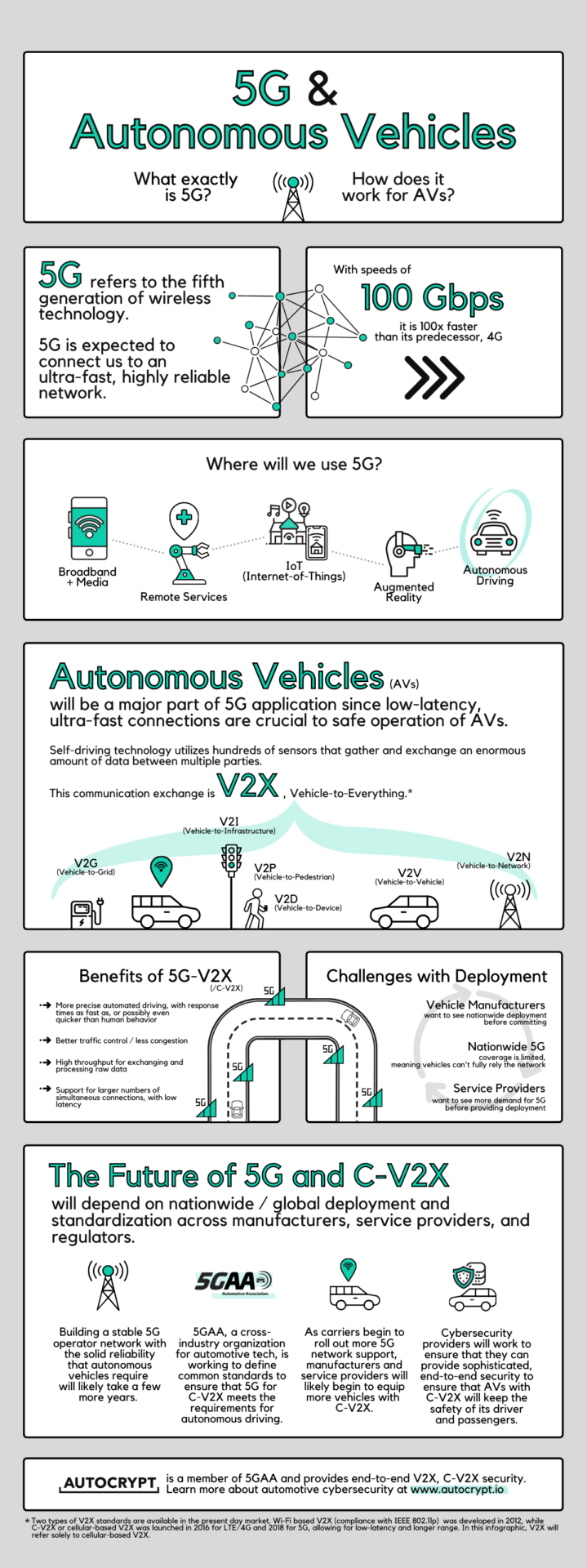5G connects at speeds up to 100x faster than 4G, 100 gigabytes per second!
While there are many applications to 5G, autonomous vehicles (AVs) will most likely be a major part of how 5G is utilized because of its critical need for a low-latency, ultra-fast connection.
Here’s an overview of what 5G connections are and why AVs will make great use of this connection.
(Accessibility version below)

5G & Autonomous Vehicles
What exactly is 5G and how does it work for AVs?
5G refers to the fifth generation of wireless technology. 5G is expected to connect us to an ultra-fast, highly reliable network. With speeds of 100 Gbps, 100 times faster than its predecessor, 4G.
Where will we use 5G connections?
- Broadband and media
- Remote services
- IoT (Internet-of-things)
- Augmented reality (AR)
- and… autonomous driving
Autonomous vehicles (AVs) will be a major part of 5G application since low-latency, ultra-fast connections are crucial to safe operation of AVs. Self driving technology utilizes hundreds of sensors that will gather and exchange an enormous amount of data between multiple parties. This communication exchange is called V2X, Vehicle-to-Everything. V2X can refer to V2G (grid), V2I (infrastructure), V2P (pedestrian), V2D (device), V2V (vehicle), and also V2N (network).
Benefits of 5G-V2X or C-V2X can allow for:
- More precise automated driving, with response times as fast as, or possibly even quicker than, human behavior
- Better traffic control, less congestion
- High throughput for exchanging and processing raw data
- Support for larger numbers of simultaneous connections with low latency.
However, there are still challenges with deployment. Vehicle manufacturers want to see nationwide deployment before committing, but nationwide 5G coverage is still limited, which means vehicles cannot yet fully rely on the network. Service providers want to see more demand for 5G before providing deployment.
The future of 5G and C-V2X will depend on nationwide / global deployment and standardization across manufacturers, service providers and regulations.
- Building a stable 5G operator network with the solid reliability that autonomous vehicles require will likely take a few more years.
- 5GAA, a cross-industry organization for automotive tech, is working to define common standards to ensure that 5G for C-V2X meets the requirements for autonomous driving
- As carriers begin to roll out more 5G network support, manufacturers and service providers will likely begin to equip more vehicles with C-V2X.
- Cybersecurity providers will work to ensure that they can provide sophisticated end-to-end security to ensure that AVs with C-V2X will keep the safety of its drivers and passengers.
AUTOCRYPT is a member of 5GAA and provides end-to-end V2X and C-V2X security. Learn more about automotive cybersecurity on our webpage.
***



